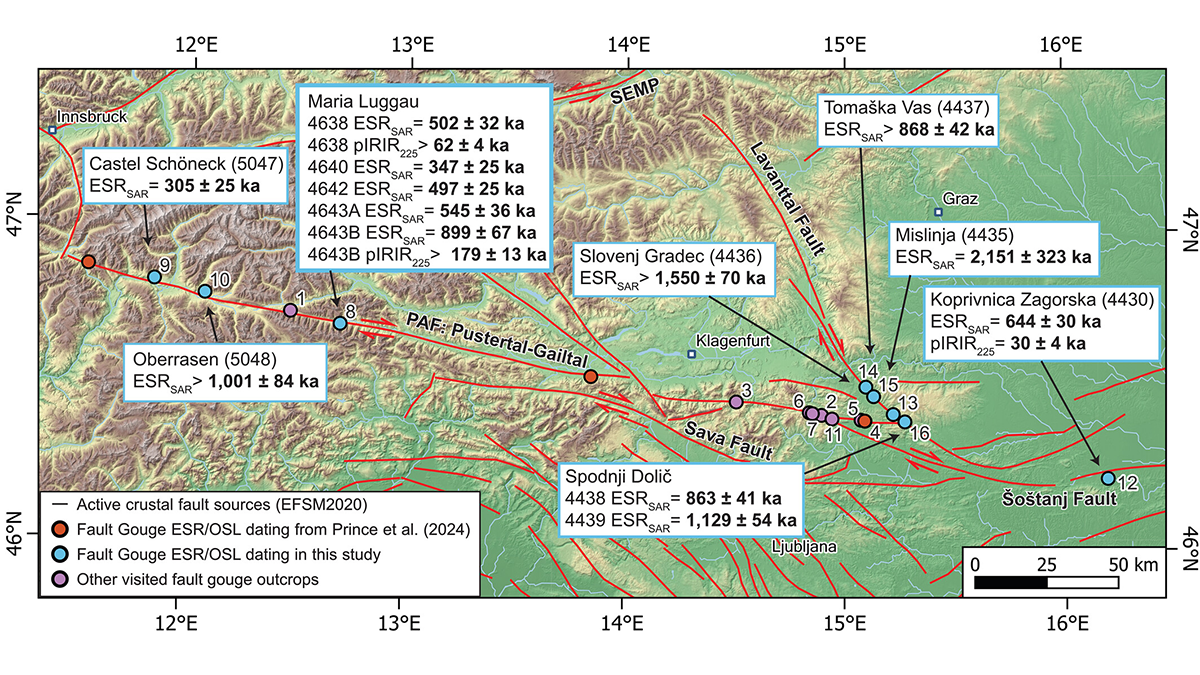Editors’ Highlights are summaries of recent papers by AGU’s journal editors.
Source: Tectonics
How do we detect past fault slip in slowly deforming regions like the Eastern Alps, where modern earthquakes are infrequent and geologic markers of seismicity are subtle or absent?
Prince et al. [2025] tackle this challenge using two innovative dating techniques: optically stimulated luminescence (OSL) and electron spin resonance (ESR). These “trapped charge” methods harness electrons that are caught in crystal defects or impurities in quartz or feldspar grains but can be released by stimuli such as light or heat. Here, the authors target quartz and feldspar in crushed fault rocks, or fault gouge. During an earthquake, work done to overcome the frictional strength of fault rocks is given off in the form of heat that may “reset” the OSL and ESR systems.
The authors compare ESR and OSL signals from fault gouges from three faults in the Eastern Alps: the Šoštanj, Periadriatic, and Lavanttal faults. They also quantify the ESR signal saturation, which gauges how close the trapped electron system is to its maximum capacity. Their results indicate that the Periadriatic and Šoštanj faults were active during the Quaternary period (the past about 2.6 million years). The Šoštanj fault shows evidence for the most recent activity, with OSL dates as young as about 30,000 years and low ESR saturation levels suggesting repeated signal resetting. In contrast, the Lavanttal fault gouge exhibits saturated ESR signals with dates ranging from about 860,000 to over 2 million years. These results imply the Lavanttal fault was seismically quiescent during the Quaternary, or the conditions of fault slip did not yield sufficient temperatures to reset the trapped charge systems.
This study spotlights the growing utility of trapped charge dating for documenting the slip histories of faults with or without historical seismicity. The analytical uncertainty of any trapped charge date (see figure above) far exceeds an individual or multiple earthquakes, and fault-slip temperatures at shallow depths can be insufficient to completely reset these systems, so it is challenging to fingerprint individual earthquakes with this approach. However, by harnessing the complementary strengths of OSL and ESR together with ESR saturation levels, the authors are able to reconstruct a fuller picture of the timing and distribution of shallow fault slip, which is critical for understanding regional tectonics and assessing seismic hazard.
Citation: Prince, E., Tsukamoto, S., Grützner, C., Bülhoff, M., & Ustaszewski, K. (2025). Deciphering Pleistocene fault activity in the Eastern Alps: Dating fault gouges with electron spin resonance and optically stimulated luminescence. Tectonics, 44, e2024TC008662. https://doi.org/10.1029/2024TC008662
—Alexis Ault, Associate Editor, Tectonics

